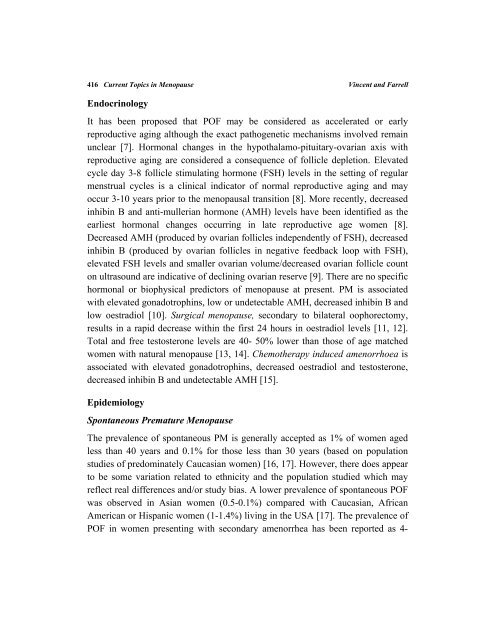Download - Bentham Science
Download - Bentham Science
Download - Bentham Science
Create successful ePaper yourself
Turn your PDF publications into a flip-book with our unique Google optimized e-Paper software.
416 Current Topics in Menopause Vincent and Farrell<br />
Endocrinology<br />
It has been proposed that POF may be considered as accelerated or early<br />
reproductive aging although the exact pathogenetic mechanisms involved remain<br />
unclear [7]. Hormonal changes in the hypothalamo-pituitary-ovarian axis with<br />
reproductive aging are considered a consequence of follicle depletion. Elevated<br />
cycle day 3-8 follicle stimulating hormone (FSH) levels in the setting of regular<br />
menstrual cycles is a clinical indicator of normal reproductive aging and may<br />
occur 3-10 years prior to the menopausal transition [8]. More recently, decreased<br />
inhibin B and anti-mullerian hormone (AMH) levels have been identified as the<br />
earliest hormonal changes occurring in late reproductive age women [8].<br />
Decreased AMH (produced by ovarian follicles independently of FSH), decreased<br />
inhibin B (produced by ovarian follicles in negative feedback loop with FSH),<br />
elevated FSH levels and smaller ovarian volume/decreased ovarian follicle count<br />
on ultrasound are indicative of declining ovarian reserve [9]. There are no specific<br />
hormonal or biophysical predictors of menopause at present. PM is associated<br />
with elevated gonadotrophins, low or undetectable AMH, decreased inhibin B and<br />
low oestradiol [10]. Surgical menopause, secondary to bilateral oophorectomy,<br />
results in a rapid decrease within the first 24 hours in oestradiol levels [11, 12].<br />
Total and free testosterone levels are 40- 50% lower than those of age matched<br />
women with natural menopause [13, 14]. Chemotherapy induced amenorrhoea is<br />
associated with elevated gonadotrophins, decreased oestradiol and testosterone,<br />
decreased inhibin B and undetectable AMH [15].<br />
Epidemiology<br />
Spontaneous Premature Menopause<br />
The prevalence of spontaneous PM is generally accepted as 1% of women aged<br />
less than 40 years and 0.1% for those less than 30 years (based on population<br />
studies of predominately Caucasian women) [16, 17]. However, there does appear<br />
to be some variation related to ethnicity and the population studied which may<br />
reflect real differences and/or study bias. A lower prevalence of spontaneous POF<br />
was observed in Asian women (0.5-0.1%) compared with Caucasian, African<br />
American or Hispanic women (1-1.4%) living in the USA [17]. The prevalence of<br />
POF in women presenting with secondary amenorrhea has been reported as 4-
















